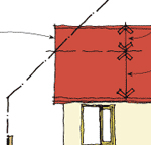Site Use
Considering how a building and site impact on each other, enhancing energy efficiency, comfort and convenience.
District Plan requirements
Each city or district council in Aotearoa New Zealand has its own regulations set out in a District Plan. These deal with issues of land use and subdivision, and all site usage and development must comply with them.
Issues covered include aspects of design and construction such as the height, location and site coverage of buildings, and the emission of noise, glare or odours from activities carried out on the site.
On this page:
- District Plan activities
- applying for resource consent
District Plan activities
Each city or district is divided into zones, for example, inner residential, outer residential, commercial, suburban and industrial. Within each zone, activities are defined according to their actual or potential adverse effects on the environment. Classifications of activities are:
- permitted
- controlled
- discretionary – restricted
- discretionary – unrestricted
- non-complying.
The type of activity determines the requirement to obtain resource consent within each zone.
| Activity | Definition | Resource consent required? |
| Permitted | Activity may be undertaken as of right and will not require a resource consent. | No |
| Controlled | A consent will be granted, but conditions relating specifically to the controlled activities for the zone may be imposed. | Yes |
| Discretionary (restricted) | A consent may be granted and, if so, may have conditions imposed relating to specific issue(s) defined in the District Plan. | Yes |
| Discretionary (unrestricted) | A consent may be granted and, if so, may have conditions imposed on the consent. | Yes |
| Non-complying | A consent may be granted but only if the council is satisfied that the consent will be consistent with the policies and objectives of the District Plan, and conditions may be imposed. | Yes |
For permitted activities, the District Plan sets out the rules such as:
- distances from boundaries
- overall height and form requirements for buildings
- sunlight access or height recession planes
- site coverage.
Height restrictions generally exclude antennas, aerials, chimneys, a portion of a gable and architectural features such as finials.

- Height restrictions on gable ends
Gable ends may usually penetrate the height recession plane by 1/3 of the gable end height.
If the proposed design meets all the permitted activity criteria for a zone, resource consent is not required. However, limiting design options to the permitted activities may compromise a building desig
Applying for resource consent
If the proposed design comes under the criteria of a controlled, discretionary (restricted or unrestricted) or non-complying activity, resource consent is required. Before making an application, consult neighbours to obtain agreement in principle for the proposal.
- If neighbours are in agreement, make an application.
- If neighbours’ agreement is not forthcoming, either:
- consider revising the design, or
- lodge a resource consent application regardless – consent may still be granted without neighbours’ agreement.
Agreement in principle from all neighbours does not guarantee resource consent will be granted, and a resource consent application must still be made for controlled, discretionary and non-complying activities.
National Policy Statement on Urban Development 2020
In July 2020 the Government released the National Policy Statement on Urban Development 2020. This document, which came into force in August 2020, sets out specific urban planning requirements that local authorities must meet, with timeframes for compliance. The Policy Statement has a strong focus on housing. Many local authorities are now updating their District Plans to meet the new requirements.
In December 2021, amendments to the Resource Management Act added a new Schedule 3A to enable greater housing intensification in urban areas. This included introducing (in Schedule 3A Part 2) Medium Density Residential Standards.
Updated: 22 September 2023

